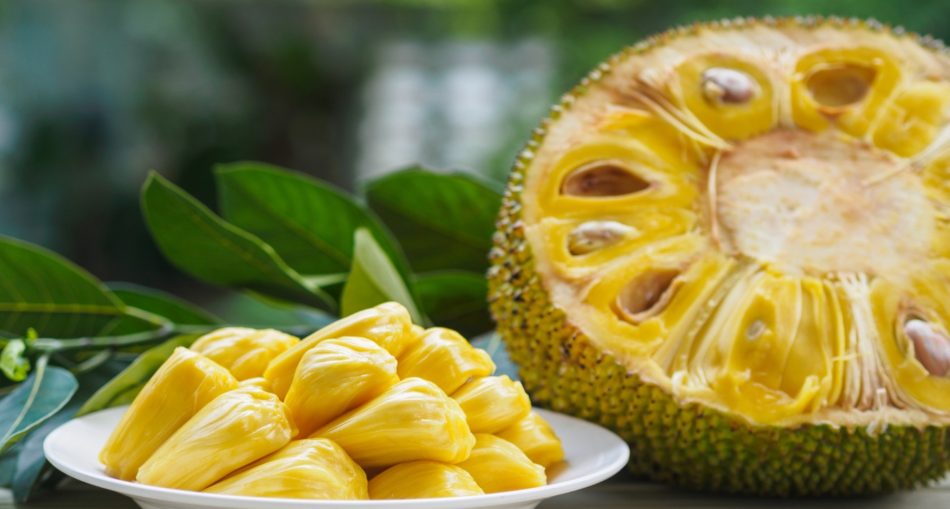The jackfruit (Artocarpus heterophyllus), also known as jack tree and locally as Koa in Guyana, is a species of tree in the fig, mulberry, and breadfruit family (Moraceae). Its origin is in the region between the Western Ghats of southern India and the rainforests of Malaysia. At first glance, this fruit is often mistaken for the Katahar fruit which belongs to the same family. But given that the koa is much bigger in size and oblong in shape. The largest tree-borne fruit in the world, Koa can weigh up to 100 pounds and grow up to three feet long. (Though, the average size of the fruit is 10 to 25 pounds). On the inside, it contains many pale-yellow, plump bulbs, which are edible and joined at the core. The seeds can also be cooked, eaten on their own, or ground into flour. The ripe, unopened fruit has a strong, unpleasant odour. But the pulp of the opened fruit smells sweet. Due to its fibrous texture, people often use koa flesh as a meat substitute in vegetarian or vegan dishes.
In this article, I am going to refer to this fruit by its local name “Koa“. So continue to read to find out more about this super amazing fruit.
What Does Koa Taste Like?
Eaten ripe and raw, the taste of koa is sweet and similar to pineapple, mango, and banana. When it’s unripe, it has more of a neutral flavour, like a potato, and works well in savoury dishes.
Where Did Koa Come From?
Koa was originated from Southwest India and was spread throughout Southeast Asia and Tropical Africa. In the 12th century, it was introduced to the Philippines and domesticated. Today it can be found in many countries including here in Guyana.
Description Of Koa
The tree is medium-sized which grows from 28 to 80 ft in height. The leaves are dark green, elliptical, 3-12 cm broad and 5-25 cm long. The fruit is produced on side branches as well as main branches. It produces slightly oval fruit which has spiky light green skin. The fruit weighs about 3.5 to 10 kg. The interior part of the fruit possesses orange to yellow coloured bulbs that possess sweet flavoured sheaths. These bulbs possess a smooth, light brown coloured and oval seed which measures about 2-4 cm long and is 1-3 cm thick. Each fruit possesses from 100-500 edible bulbs.
There Are Six (6) Varieties Of Koa. They Are As Follows Below:
- Black Gold – This type produces medium-sized fruit of about 6.7 kg. It has a dark green exterior with the sharp fleshy spine which are zig-zag. The flesh is soft with a sweet, strong flavour as well as aroma.
- Cheena – This is an exotic fruit which produces narrow, long and uniform fruits in shape as well as size. It has green skin with blunt spines that are yellow. The fruits are small and weigh about 2.4 kg. It has deep orange flesh which is soft and fibrous. It possesses an excellent flavour with an intense and earthy aroma.
- Cochin – This fruit is small and smooth which produces the fruit of 1.5 kg. It possesses mild and firm flesh with little latex.
- Red Bartlett – This fruit is of medium and oval shape. The colour of the fruit is bright green to pale yellow in colour having a uniform shape. It has a firm and deep orange flesh with mild and sweet flavour as well as a sweet aroma.
- Golden Nugget – This variety has a dark green and rounded leaf. It possesses small, round and green fruits with fleshy spines on its skin. When it matures, the spines become smooth and turn into gold to yellow. It has deep orange flesh which is soft to medium-firm.
- Golden Pillow – It was introduced from Thailand in the 1980s. It bears the fruit of 3.6 to 5.5 kg. It contains from 65 to 75 seeds in a fruit with little latex. It has crisp and thick flesh of golden colour. It has a sweet and mild flavour.
Nutritional Content Of Koa
Koa is a healthful source of vitamin C, potassium, dietary fibre, and some other essential vitamins and minerals.
According to the United States Department of Agriculture, a cup of raw, sliced jackfruit contains:
- 157 calories
- 2.84 g of protein
- 1.06 g of fat
- 38.36 g of carbohydrates
- 2.5 g of dietary fibre
- 31.48 g of sugars
- 48 mg of magnesium
- 739 mg of potassium
- 22.6 mg of vitamin C
Here Are 5 Amazing Health Benefits Of Koa
- Promotes immunity power – Koa is a great source of Vitamin C, antioxidants as well as cancer-fighting phytonutrients such as isoflavones, lignans and saponins. It also counteracts free radicals that exist in the body. The antioxidants help to enhance immune function by eliminating the existing free radicals from the body. It counteracts cancer and strengthens the immune system.
- Provides magnesium – Magnesium is vital for maintaining the bones structure. Women have high chances of magnesium. Magnesium helps to lower high blood pressure, heart disease and diabetes by providing strong bones.
- Lowers heart problems – This fruit has a high content of Vitamin B6, Vitamin B12 and folic acid which helps to lower heart disease. It occurs due to the low content of homocysteine which is essential for the building block of protein.
- Supports digestion – Koa is helpful for digestive health and people with constipation. The seeds are the great source of dietary fibre which assists constipation and supports in weight loss.
- Treat osteoporosis – Koa has calcium which lowers the chances of osteoporosis and its onset. Osteoporosis occurs when the body is not able to replace the lost calcium. Koa is a great source of calcium which helps to treat the condition of osteoporosis.
Traditional Uses Of Koa
- Leaves ashes are used to treat diarrhoea, ulcers, stomach ache and boils.
- The decoction made from the root is used to lower fever and treat skin diseases, diarrhoea and asthma.
- The latex possesses anti-bacterial properties.
- Sap acts as a vermifuge and anti-syphilitic.
- The mixture of dried latex and vinegar is used to speed up healing of abscesses, glandular swellings and snakebites.
- The seeds and pulp of koa are used to overcome the influence of alcohol.
- Roots are used as an aid for asthma and skin diseases.
- In order to treat fever, diarrhoea and asthma, use 3-4 cups of decoction of root daily.
- The bark is used to treat boils, fever, skin problems and wounds.
- In Mauritius, it is used for the treatment of diabetes.
- The hot water extract of mature leaves is used in Ayurvedic medicine to treat diabetes.
- The bark is used to lower intestinal motility and used to treat dysentery as well as diarrhoea.
- It is helpful for the people with erectile dysfunction, low libido and premature ejaculation.
- It prevents the body from bacterial infections and viral infections.
- The daily intake of this fruit helps to prevent cancer and also eliminates free radicals.
- It assists in bowel movement.
- It helps to enhance the eyesight.
- It also assists in the clotting of blood.
- The extract of leaves and latex assist in the prevention of ringworm infestation and also heals the crack feet.
- It also lowers the appearance of wrinkles.
Precautions To Keep In Mind
- Pregnant women should not use it because it possesses sedative properties as it could promote abortion.
- It also increases coagulation in people with blood disorders.
- Its seeds provide an immunostimulating effect in the patients of immunosuppression therapy with tissue transplants.
- Koa should not be used two weeks before scheduled surgery because it might cause too much drowsiness.
- People taking blood medications such as aspirin or blood thinners should avoid it.
- Excessive consumption of koa results in abnormal stool conditions as well as upset stomach due to the high content of fibre.
Culinary Uses Of Koa
- Fruits are consumed raw.
- The seeds and pulp of young fruit are cooked as a vegetable.
- The grounded seeds are used for making biscuits.
- The seeds are boiled, roasted or baked.
- It is cooked with coconut milk in the Philippines.
- Unripe koa slices are used to make chips by deep frying in Southern India.
- koa is used to make addae and appa in Udipi cuisine.
- It is added to soups, fried and baked dishes.
- It is also preserved in syrup. Mix the slices of koa with honey, grated coconut and banana slices to make a dessert.
- The fruit could be used for preparing chutney, jelly and jam.
- The slices of fruit could be added to fruit salads.
- It is used to make fruit rolls, candies, ice cream and marmalades.
Other Uses And Facts Of Koa
- The wood is used to make furniture, musical instruments and house construction.
- Each tree could produce from 100 to 200 fruits per year.
- Koa is composed of about 80% water.
- It possesses the flavour of a mixture of banana, mango, papaya and melon.
- Koa possesses 100 to 500 seeds.
Koa In Guyana
Koa is a good source of vitamin C, potassium, dietary fibre, and other important vitamins and minerals. It is a popular meat substitute. Koa is safe and nutritious for most people.
Article References:
- https://foodrevolution.org/blog/what-is-jackfruit/
- https://www.healthbenefitstimes.com/jackfruit/
- https://en.m.wikipedia.org/wiki/Jackfruit
- https://www.medicalnewstoday.com/articles/324787.php#summary
- Main Image by: Lovefood (jackfruit in a plate) – https://www.lovefood.com/guides/87925/what-is-jackfruit







